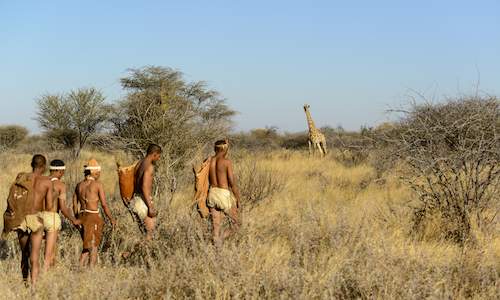
Their chief focus is on education, promoting the sustainable utilisation of all natural tourism resources and to encourage and facilitate the active participation of citizens in the tourism industry.
High Cost - Low Volume Eco-Tourism
Although most of Botswana is classified as being semi-arid, the country still has a large wildlife population. These animals are mostly free-ranging, as they occur not only in the designated parks and reserves, but also within community areas and across tribal lands throughout most of the country.
This feature gives the country an invaluable competitive advantage within Africa that serves as a major drawcard for safari tourists. But, because of the fragile environment, and out of a desire to avoid the more mass-market type safari experience found in parts of east and southern Africa, the country has chosen to manage its wildlife resources according to the 'high cost-low volume' maxim.
In essence, the aim is to manage the wildlife areas in a sustainable manner by attracting fewer visitors, who pay higher average prices. The result is that excessive pressure is not placed on the country's natural resources and visitors experience a more exclusive safari, and also one in pristine conditions.
The Department of Wildlife and National Parks (DWNP), the regional land boards and various other government agencies, enforce this principle, as it's laid out in the Wildlife Conservation Policy, the National Conservation Strategy and a number of tourism acts introduced in the early 1990s.
Tourism Bytes
- Approximately 17 percent of the country has been set aside in national parks and game reserves, and another 22 percent has been allocated to Wildlife Management Areas (WMAs). With 39 percent of its land under either national, private or community protection, Botswana ranks in the top three countries in the world for conservation.
- Prior to 1995 most of the wildlife areas were controlled as hunting concessions and were largely under-utilised. That changed with the new Land Utilisation acts and the subsequent boom in the photographic safari sector is what has given the tourism industry its primary boost over the last decade. It's viewed as the main growth industry for the future.
- Botswana is now ranked in the top five most popular destinations in Africa.
- The vision statement of the Department of Tourism says that: 'By the year 2009, we, the Department of Tourism, will have facilitated the development, diversification and promotion of sustainable tourism products, thereby positioning Botswana amongst the top ten preferred destinations in the world.'
- The Department of Tourism falls under the Ministry of Environment, Wildlife and Tourism, and was only created in 1994, giving an indication of how young the industry still is.
- In the latest statistical report put out by the Department of Tourism, international tourism receipts had grown from US$136 million in 1997 to US$313 million by 2002.
- The same report noted that there were 442 licensed tourism enterprises at the end of 2002, up from 202 in 1998. The number of tented camps and lodges has increased from 77 to 158, and the number of mobile safari operators from 54 to 134.
- Of the 442 tourism enterprises with licenses, 178 are citizen owned (47 in 1998), 148 are non-citizen owned (81 in 1998) and 116 are joint ventures (74 in 1998).

 Botswana Eco-tourism information on eco-friendly safari lodges and responsible tourism which does not negatively impact the environment......
Botswana Eco-tourism information on eco-friendly safari lodges and responsible tourism which does not negatively impact the environment......